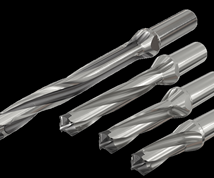Five Facts about Diamond-Coated Tools
Points for the toolmaker to ponder before choosing and using diamond-coated tools.
1. There are differences between CVD diamond and amorphous diamond.
Amorphous diamond is a carbon film that is applied using physical vapor deposition. It has some of the SP3 bonds that diamond has and some of the SP2 bonds that carbon has. The resulting film is hard, but not as hard as diamond. It also is not as thick as we typically deposit diamond. In graphite, this results in two to three times the life of bare carbide. In comparison, a CVD diamond film is pure diamond and is made with a process called chemical vapor deposition. Diamond films last 12 to 20 times the life of carbide in graphite. This of course results in fewer tool changes, fewer opportunities for error and more consistent tolerance.
2. You cannot use diamond tools on hardened steel.
Diamond is composed of carbon atoms. Some materials, when heated will absorb carbon to form carbides in the workpiece. Unfortunately iron is one such material. When machining ferrous materials, friction provides the heat necessary to cause the right conditions for the carbon from the diamond to diffuse into the iron, causing chemical wear of the film. This results in premature wear and the diamond cannot pay for itself.
Featured Content
3. A resharpened and/or recoated diamond-coated tool cannot be guaranteed.
Since the film produced is pure diamond, resharpening the tool with a diamond wheel will take a long time. In addition, the process used to prepare the tool for diamond growth alters the chemistry of the tool at the surface. Since this chemistry needs to be very closely managed, the results of a tool that has been recoated cannot be guaranteed.
4. The life of a diamond-coated tool varies.
Like any other tool, the life of a diamond-coated tool will vary depending on the material being cut, the chosen feeds and speeds, and the geometry of the part. As a rule, graphite diamond-coated tools will last 10 to 20 times as long as a bare tungsten carbide tool. In some cases it could last even longer than that. This will allow almost any job to be done completely with one tool with no change due to wear, no interruption and no recalibration, and this allows lights-out operation. In composite materials it is not unusual to get substantially longer life. Up to 70 times the life of a bare carbide tool in high-density fiberglass, carbon fiber and G10-FR4 has been reported.
5. Peeling off of diamond-coated tools can be prevented.
This has been a serious problem with diamond-coated tools. In the late 1990s, interface chemistry was identified as the important issue in adhesion of the diamond film. By selecting compatible carbide chemistry, and using suitable preparation techniques and proper reactor conditions, the issue of diamond peeling off can be eliminated. When diamond-coated tools are worn out, examination under a microscope reveals that the diamond has worn all the way through to the carbide rather than chipping or peeling off (see Photos).
RELATED CONTENT
-
7 Key Advantages of Hot Runner Systems
While both hot runner and cold runner systems have their benefits, for design flexibility as well as reduced cycle times and costs, hot runner systems will probably be the better choice.
-
Four Key Uses of Prototyping
Prototyping helps evaluate and test a design, clarify production costs, sell a product and secure patents.
-
Plastic Prototypes Using Silicone Rubber Molds
How-to, step-by-step instructions that take you from making the master pattern to making the mold and casting the plastic parts.












